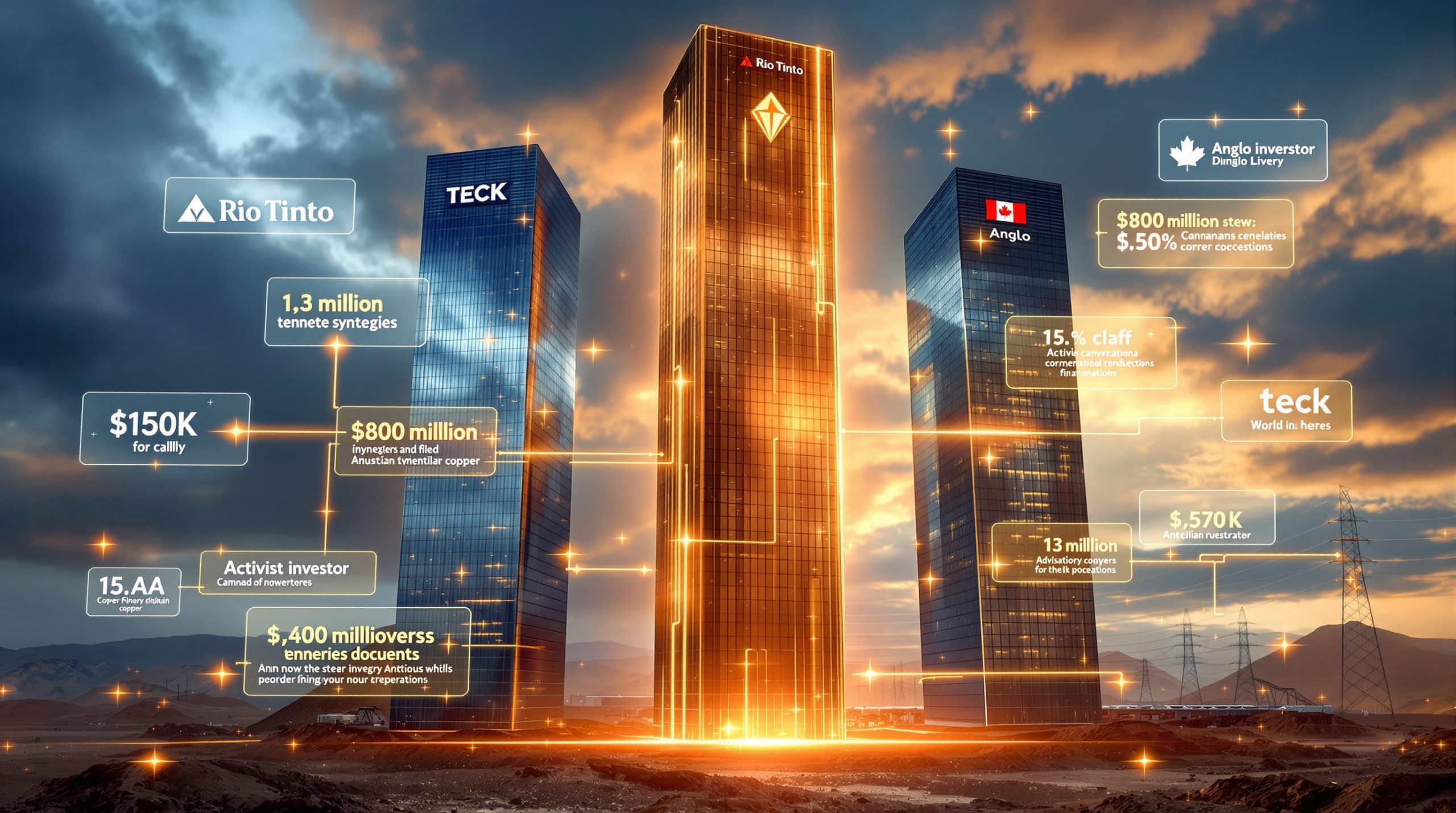Revolutionizing Mining: Battery Technology and Electrification Transforming the Industry
Mining operations worldwide are undergoing a profound transformation through battery technology and electrification in mining. This shift represents not just an incremental improvement but a fundamental reimagining of how mining companies operate, addressing both environmental concerns and operational efficiency. Leading this charge are innovative partnerships between mining giants and battery technology leaders, creating solutions specifically designed for the unique challenges of mining environments.
What is Driving Battery Technology and Electrification in Mining?
The mining industry faces unprecedented pressure to reduce its environmental footprint while maintaining operational efficiency. This pressure comes from multiple fronts, creating a perfect storm that is accelerating the adoption of battery technology and electrification across the sector.
The Decarbonization Imperative in Mining Operations
Global mining companies are setting increasingly ambitious sustainability targets, with many committing to net-zero emissions by mid-century. BHP, one of the world's largest mining companies, has pledged to achieve net-zero operational greenhouse gas emissions by 2050, signaling the industry's recognition of climate change as a critical business challenge.
"Together with forward-thinking mining companies like BHP, we aim to demonstrate how advanced battery technologies can decarbonise mining operations, logistics and product delivery," states Tan Libin, senior vice president at CATL, the world's largest battery manufacturer.
The regulatory landscape is also evolving rapidly, with governments worldwide implementing stricter emissions standards for heavy industries. Mining operations, which traditionally rely heavily on diesel-powered equipment, are particularly affected by these regulations.
- Financial pressures are mounting as diesel costs fluctuate and carbon pricing mechanisms become more common
- Investor scrutiny is intensifying, with ESG metrics increasingly influencing investment decisions
- Community expectations are evolving, with local stakeholders demanding cleaner operations
These factors combine to create a compelling business case for electrification powering mines beyond just environmental benefits.
Current Challenges in Mining Electrification
Despite the clear imperative, mining electrification faces substantial technical hurdles that require specialized solutions beyond those developed for consumer electric vehicles or even commercial transportation.
Mining environments present extreme challenges for battery technology:
- Harsh operating conditions including extreme temperatures, dust, vibration, and moisture
- Heavy-duty power requirements for equipment that operates continuously under high loads
- Remote locations with limited access to electrical infrastructure
- Safety considerations specific to mining environments with combustible materials
These technical challenges require purpose-built solutions rather than simply adapting technologies from other sectors.
How Are Major Mining Companies Embracing Electrification?
Industry leaders are forming strategic partnerships to accelerate the development and deployment of mining-specific battery solutions.
BHP's Strategic Partnerships for Mining Electrification
BHP has established groundbreaking partnerships with battery technology leaders to accelerate its transition to electrified operations. In July 2025, BHP signed memoranda of understanding with both CATL and FinDreams Battery (a subsidiary of BYD) to collaborate on multiple aspects of mining electrification.
These partnerships focus on developing:
- Battery solutions for mining equipment and locomotives
- Fast-charging infrastructure specifically designed for mining applications
- Energy storage systems for mining operations
- Battery recycling technologies leveraging BHP's copper operations
Jack Li, the chief executive of FinDreams Battery, described the partnership as "a pivotal milestone for accelerating decarbonisation across the global resources sector."
The collaboration with BYD includes evaluating commercial and light vehicles for mining applications, with the goal of replacing diesel-powered vehicles across BHP's operations.
Key Technology Partners in Mining Electrification
Mining companies are collaborating with technology providers across multiple domains to create comprehensive electrification solutions:
- Battery manufacturers like CATL and BYD developing mining-specific battery chemistry and form factors
- Vehicle OEMs adapting or purpose-building electric vehicles for mining environments
- Charging infrastructure specialists creating solutions for remote and harsh environments
- Energy management software providers optimizing battery utilization and charging schedules
These collaborations bridge the gap between mining expertise and battery technology innovation, accelerating the pace of electrification.
What Battery Technologies Are Being Developed Specifically for Mining?
The unique demands of mining operations require specialized battery solutions that differ significantly from those used in consumer or even commercial applications.
Heavy Equipment Battery Solutions
Mining equipment places extraordinary demands on battery systems, requiring innovations across multiple dimensions:
- Ruggedized designs with reinforced casings and shock absorption systems to withstand constant vibration and potential impacts
- Enhanced thermal management systems that maintain optimal operating temperatures in extreme environments
- Modular battery architecture allowing for quick replacement of damaged components
- Higher energy density to enable practical operating times for heavy equipment
These specialized batteries must deliver reliable performance under conditions that would quickly destroy conventional battery systems.
Locomotive and Transport Electrification
Mining operations often rely on rail systems for moving ore and equipment, presenting both challenges and opportunities for electrification:
- Battery-electric locomotives that eliminate diesel emissions entirely
- Hybrid systems combining batteries with traditional power sources for extended range
- Regenerative braking that captures energy during downhill transport of heavy materials
- Wireless charging technologies enabling automatic power replenishment at loading/unloading points
CATL's collaboration with BHP specifically mentions locomotive electrification as a key focus area, recognizing the significant emissions reduction potential in this application.
Fast-Charging Infrastructure Innovations
One of the most significant barriers to mining electrification is charging time, which directly impacts operational efficiency. Innovative solutions are emerging to address this challenge:
- Ultra-rapid charging systems capable of delivering significant range in minutes
- Mobile charging platforms that can be deployed throughout mining operations
- Smart charging management optimizing power delivery based on operational priorities
- Battery swapping systems enabling near-zero downtime for critical equipment
CATL has developed fast-charging technology that promises 520km of range from just 5 minutes of charging, though adaptations would be needed for mining applications with their different power profiles.
What Are the Environmental Benefits of Mining Electrification?
The environmental case for mining electrification extends beyond simple carbon reduction, encompassing multiple benefits across various impact categories.
Reduction in Greenhouse Gas Emissions
Mining operations are significant contributors to global carbon emissions, with diesel-powered equipment being a major source:
- Direct elimination of exhaust emissions from vehicles and equipment
- Reduction in Scope 1 emissions helping mining companies meet climate commitments
- Decreased carbon intensity of mined materials, potentially commanding premium pricing
- Progress toward industry decarbonization targets set by organizations like ICMM
For a typical large mining operation, electrification of heavy equipment can reduce site emissions by 30-50%, representing millions of tons of CO₂ annually.
Improved Air Quality and Working Conditions
Beyond climate impacts, electrification delivers immediate health and safety benefits for mining workers:
- Elimination of diesel particulate matter which is classified as a human carcinogen
- Reduced noise levels improving communication and reducing hearing damage
- Lower heat generation improving comfort in underground environments
- Decreased ventilation requirements in underground mines, saving energy and costs
"The health benefits alone create a compelling case for electrification, particularly in underground operations where ventilation costs are substantial," notes a recent International Council on Mining and Metals report.
These improvements contribute to both worker wellbeing and operational efficiency.
How Does Battery Recycling Create New Value Chains in Mining?
Mining companies are uniquely positioned to capitalize on the growing battery recycling breakthrough industry, creating circular economy opportunities.
Sustainable Battery Lifecycle Management
The BHP-CATL partnership specifically mentions battery recycling options, recognizing the strategic opportunity to integrate mineral production with end-of-life battery processing:
- Integration of recycling facilities with existing mineral processing infrastructure
- Recovery of critical materials including lithium, cobalt, nickel, and manganese
- Reduced primary resource extraction through circular material flows
- Development of closed-loop battery supply chains with manufacturers
This approach transforms mining companies from purely extractive operations to integrated materials management enterprises, potentially capturing value across the entire battery recycling process.
Copper's Role in Battery Recycling
BHP's partnership with CATL specifically mentions leveraging BHP's copper operations to enhance recycling processes:
- High copper content in battery components, particularly in connectors and busbars
- Established copper recycling expertise applicable to battery recycling processes
- Enhanced recovery technologies specifically optimized for battery-grade materials
- Integration potential between copper mining and battery recycling operations
This synergy between BHP's traditional copper business and emerging battery recycling opportunities demonstrates how mining companies can leverage existing expertise in new directions.
What Economic Benefits Does Electrification Bring to Mining Operations?
Beyond environmental considerations, the business case for mining electrification is strengthening as technology matures and energy economics evolve.
Operational Cost Reductions
Electric equipment offers substantial operational advantages that translate to cost savings:
- Lower maintenance requirements with fewer moving parts and fluids
- Reduced energy costs especially when combined with renewable energy solutions
- Decreased ventilation needs in underground operations, saving 30-40% of energy costs
- Extended equipment lifespan due to reduced mechanical stress
These savings can offset the higher initial capital costs of electric equipment, particularly as battery prices continue to decline and energy prices rise.
New Revenue Opportunities
Electrification enables mining companies to participate in emerging markets and value streams:
- Grid services revenue through battery storage participation in frequency regulation
- Carbon credit generation from verified emissions reductions
- Premium pricing for low-carbon materials from responsible producers
- Energy arbitrage opportunities through strategic charging and discharging
These additional revenue streams further improve the business case for battery metals investment and electrification initiatives.
How Will Battery Technology Transform Future Mining Operations?
The integration of battery technology with other technological trends is creating opportunities for fundamental transformation of mining operations.
Autonomous Electric Mining Equipment
The combination of electrification and autonomy creates powerful synergies:
- Simplified automation due to more precise control of electric drivetrains
- Extended operational hours through optimized energy management
- Reduced human exposure to hazardous environments
- Increased precision in material extraction and handling
Electric autonomous equipment can operate continuously with minimal human intervention, optimizing both energy use and material recovery.
Energy Storage Systems for Mining Sites
Beyond mobile equipment, stationary battery systems offer significant benefits for mining operations:
- Peak load management reducing demand charges and infrastructure requirements
- Integration with renewable energy enabling higher penetration of solar and wind
- Microgrid capabilities enhancing energy security in remote locations
- Backup power provision improving operational resilience
These systems can transform mines from energy consumers to sophisticated energy prosumers, potentially reducing costs while improving reliability.
What Challenges Remain in Mining Electrification?
Despite promising developments, significant hurdles remain on the path to fully electrified mining operations.
Technical Barriers to Full Electrification
Current battery technology still faces limitations in mining applications:
- Energy density constraints for the heaviest equipment like ultra-class haul trucks
- Charging infrastructure deployment challenges in extremely remote locations
- Integration complexities with existing fleet management systems
- Thermal management requirements for deep underground operations
These technical challenges require continued innovation and mining-specific engineering solutions, as outlined by industry experts.
Investment and Implementation Hurdles
Beyond technology, practical implementation faces business and organizational challenges:
- High upfront capital costs despite favorable lifetime economics
- Workforce training requirements for maintenance and operation of electric systems
- Supply chain uncertainties for battery raw materials and components
- Operational disruption risks during transition periods
Mining companies must develop comprehensive change management strategies to address these implementation challenges.
How Are Global Mining Leaders Implementing Electrification Strategies?
Leading mining companies are taking varied approaches to electrification, providing valuable lessons for the broader industry.
Case Studies of Successful Mining Electrification
BHP's partnerships with CATL and BYD represent one approach, focusing on co-developing specialized solutions. Other notable examples include:
- Newmont's all-electric Borden mine in Ontario, eliminating diesel equipment underground
- Anglo American's hydrogen fuel cell mining truck pilot program
- Rio Tinto's autonomous electric rail system in Western Australia
These early implementations demonstrate both the potential and the diversity of approaches to mining electrification.
Industry Collaboration Accelerating Adoption
The mining industry is increasingly collaborating on electrification challenges:
- Pre-competitive research initiatives through organizations like ICMM and GMG
- Shared charging infrastructure in mining hubs with multiple operators
- Standardization efforts for battery interfaces and charging protocols
- Joint technology development spreading costs across multiple companies
This collaborative approach accelerates innovation while reducing individual company risk.
FAQs About Battery Technology and Electrification in Mining
What types of mining equipment are being electrified first?
The electrification journey typically begins with the most accessible applications:
- Light-duty vehicles used for personnel transportation and supervision
- Underground equipment where diesel emissions create significant ventilation requirements
- Material handling equipment in processing facilities
- Stationary applications like pumps, conveyors, and crushers
The heaviest applications, like ultra-class haul trucks, present the greatest challenges and are generally later in the electrification roadmap.
How do mining batteries differ from electric vehicle batteries?
Mining applications require specialized battery characteristics:
- Enhanced durability with reinforced components to withstand vibration and impacts
- Superior thermal management for operation in extreme temperatures
- Higher power delivery capability for heavy equipment operations
- Modular designs enabling easier maintenance and component replacement
These specialized requirements often result in different cell chemistry and pack design compared to automotive applications.
What is the expected timeline for widespread mining electrification?
The transition to fully electrified mining operations will be gradual:
- 2025-2030: Widespread adoption of battery-electric light vehicles and selected medium-duty equipment
- 2030-2035: Commercialization of battery-electric solutions for most underground equipment
- 2035-2040: Mainstream adoption of battery-electric or hybrid solutions for heavy surface equipment
- 2040-2050: Potential for fully electrified mining operations aligned with net-zero commitments
This timeline varies significantly by region, commodity, and operation type.
How does mining electrification impact local communities?
Electrification creates multiple benefits for communities near mining operations:
- Reduced noise and air pollution improving quality of life
- Decreased water usage for dust suppression due to lower dust generation
- New skilled employment opportunities in battery maintenance and electrical systems
- Potential shared infrastructure benefits like improved power reliability
These community benefits enhance mining companies' social license to operate while contributing to regional development goals.
Mining's electrification journey represents one of the most significant technological transformations in the industry's history. Through partnerships like those between BHP, CATL, and BYD, the mining sector is accelerating its transition toward a more sustainable and efficient future. As battery technology and electrification in mining continues to evolve and deployment expands, mining operations worldwide will increasingly benefit from the environmental, operational, and economic advantages of electrification.
Ready to Stay Ahead of Mining Technology Advancements?
Stay informed on the latest developments in mining electrification and battery technology with Discovery Alert's proprietary Discovery IQ model, which provides real-time notifications on significant ASX mineral discoveries that could benefit from these technological transformations. Visit our dedicated discoveries page to understand how major mineral discoveries can generate substantial returns for early investors.




